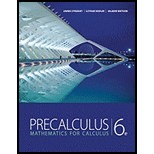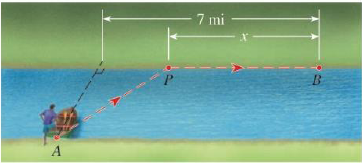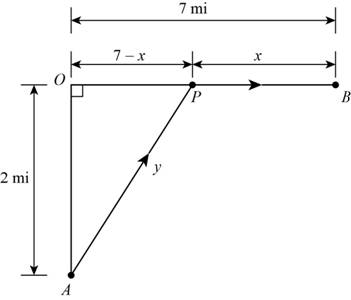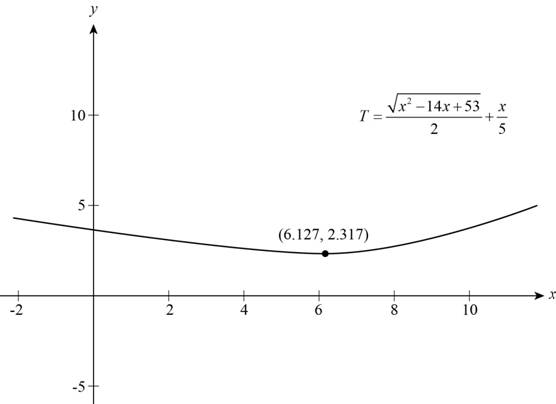
Concept explainers
Minimizing Time A man stands at a point A on the bank of a straight river, 2 mi wide. To reach point B, 7 mi downstream on the opposite bank, he first rows his boat to point P on the opposite bank and then walks the remaining distance x to B, as shown in the figure. He can row at a speed of 2 mi/h and walk at a speed of 5 mi/h.
- (a) Find a function that models the time needed for the trip.
- (b) Where should he land so that he reaches B as soon as possible?

(a)
To find: The function that models the time needed by the man for the trip.
Answer to Problem 30P
The function that models the time taken by the man is
Explanation of Solution
Given:
Width of river is
Calculation:
Draw the figure according to given situation in the question as shown below.

Figure (1)
In the Figure (1)
The man reaches at point
Width of river
Total time of the trip is sum of time taken to cross the river and time taken to walk the remaining distance.
Let time taken to cross the river be
Total time
The formula to calculate
Distance travelled by the boat is
Apply Pythagorean Theorem in triangle
Substitute
Take square root of above equation.
Substitute
The formula to calculate
Substitute 5 for
Summarize all the information in the table as shown below.
| In Words | In Algebra |
| Total time for the trip |
|
| Time taken to cross the river |
|
| Time taken in walking |
|
Use the information in the table and model the function.
Thus, the function that models the time taken by the man is
(b)
To find: The point at which the man should reach to minimize the time of trip.
Answer to Problem 30P
The distance is
Explanation of Solution
The function that models the time as calculated in part(a) is
Sketch the graph of the function as shown below.

Figure (2)
Observe from the graph that function attains a minimum value when x is
Thus, man should land at distance of
Chapter 2 Solutions
EBK PRECALCULUS: MATHEMATICS FOR CALCUL
- I circled the correct, could you explain using stokearrow_forwardUse Euler's method to numerically integrate dy dx -2x+12x² - 20x +8.5 from x=0 to x=4 with a step size of 0.5. The initial condition at x=0 is y=1. Recall that the exact solution is given by y = -0.5x+4x³- 10x² + 8.5x+1arrow_forwardFind an equation of the line tangent to the graph of f(x) = (5x-9)(x+4) at (2,6).arrow_forward
- Find the point on the graph of the given function at which the slope of the tangent line is the given slope. 2 f(x)=8x²+4x-7; slope of the tangent line = -3arrow_forwardUse the product rule to find the derivative of the following. p(y) (y¹ + y²) (6y¯³-10y¯4)arrow_forwardplease dont use chat gptarrow_forward
- Find this expression in frequency domain in a expression y(t), in time, that is.arrow_forwardplease dont use chat gptarrow_forwardQuestion Given the graph of f(z) below, find the graph of the derivative of f(z). Select the correct answer below: ° 7-6-5-4-3 123 ° ° 2 -7-6-5-4-3- 123 -° 2-4 -°- °- -7-6-5-4-3-2-1 1 5 +arrow_forward
 Calculus: Early TranscendentalsCalculusISBN:9781285741550Author:James StewartPublisher:Cengage Learning
Calculus: Early TranscendentalsCalculusISBN:9781285741550Author:James StewartPublisher:Cengage Learning Thomas' Calculus (14th Edition)CalculusISBN:9780134438986Author:Joel R. Hass, Christopher E. Heil, Maurice D. WeirPublisher:PEARSON
Thomas' Calculus (14th Edition)CalculusISBN:9780134438986Author:Joel R. Hass, Christopher E. Heil, Maurice D. WeirPublisher:PEARSON Calculus: Early Transcendentals (3rd Edition)CalculusISBN:9780134763644Author:William L. Briggs, Lyle Cochran, Bernard Gillett, Eric SchulzPublisher:PEARSON
Calculus: Early Transcendentals (3rd Edition)CalculusISBN:9780134763644Author:William L. Briggs, Lyle Cochran, Bernard Gillett, Eric SchulzPublisher:PEARSON Calculus: Early TranscendentalsCalculusISBN:9781319050740Author:Jon Rogawski, Colin Adams, Robert FranzosaPublisher:W. H. Freeman
Calculus: Early TranscendentalsCalculusISBN:9781319050740Author:Jon Rogawski, Colin Adams, Robert FranzosaPublisher:W. H. Freeman
 Calculus: Early Transcendental FunctionsCalculusISBN:9781337552516Author:Ron Larson, Bruce H. EdwardsPublisher:Cengage Learning
Calculus: Early Transcendental FunctionsCalculusISBN:9781337552516Author:Ron Larson, Bruce H. EdwardsPublisher:Cengage Learning





